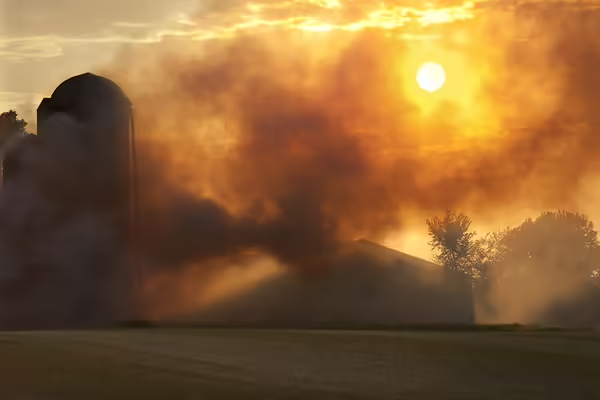
URBANA, Ill. — Severe drought and current environmental conditions have the Midwest on alert as fire risks are higher than usual during equipment rollout for corn and soybean harvest. From lack of precipitation to low soil moisture and dry vegetation, these conditions, when paired with hot, running farm equipment, increase fire chances.
“Contributing environmental risk factors for fire include a lack of precipitation, low soil moisture, low humidity, high winds, and warm daily temperatures,” says Trent Ford, state climatologist with Illinois State Water Survey at University of Illinois Urbana-Champaign.
When dry fields and environmental risks combine with long work hours, delayed equipment maintenance and cleaning, part failures, and debris-clogged cooling systems — chances of a fire starting are greatly increased, says Ford.
Prepare for high fire risk conditions with farm fire safety tips from climate and agricultural safety experts at University of Illinois Extension, Illinois Water Survey, USDA Agricultural Research Service, NOAA, and Illinois Emergency Management Agency.
- Check the weather forecast. If conditions are expected to be dry and windy, wait.
- Ensure the farm address is clearly visible from the road.
- Always know the exact field identification and location.
- Access to water, fire extinguishers, and fire blankets.
- Access to equipment to create potential fire breaks.
- Maintain, clean, and monitor equipment for fire potential.
- Smoke detectors in buildings with alerts connected to a phone.
- Have a plan for all livestock.
Equipment fires, specifically combine-related fires, are one of the most common and expensive types of incidents in production agriculture. Fires not only put producers’ lives at risk, but there is a chance of total loss of equipment and crops, pausing harvest until standby is available.
“Farm harvest delays cause stress and anxiety for farmers and their families,” says Extension Specialist and Department of Agricultural and Biological Engineering Assistant Professor Josie Rudolphi.
Like equipment, straw and hay can become combustibles, systems can have electrical flaws or pumps run dry, and during quick repairs, there is always a chance of sparking off welders, causing ignitions.
“It is extremely important to inspect farm buildings and evaluate storage conditions and upkeep,” says Jay Solomon, Illinois Extension educator whose focus is farm facility management.
Harvest takes over the fall season in the Midwest, but day-to-day farm operation decisions are critical to ensure a profitable crop and safe harvest season. Increased awareness, preparation, and slowing down for safety may help to save a life.
For more information and resources on farm fire risks, download the fact sheet at go.illinois.edu/FarmFireRisks. For questions, contact Illinois Extension at extension.illinois.edu.
SOURCES: Trent Ford, State Climatologist, University of Illinois Urbana-Champaign; Josie Rudolphi, Extension Specialist and Assistant Professor, Agricultural and Biological Engineering, University of Illinois Urbana-Champaign; Jay Solomon, Natural Resources, Environment, and Energy Educator, Illinois Extension.
WRITER: Jenna Braasch, Media Communications Coordinator, Illinois Extension
Illinois Extension leads public outreach for University of Illinois by translating research into action plans that allow Illinois families, businesses, and community leaders to solve problems, make informed decisions, and adapt to changes and opportunities. Illinois Extension is part of the University of Illinois Urbana-Champaign College of Agricultural, Consumer and Environmental Sciences.